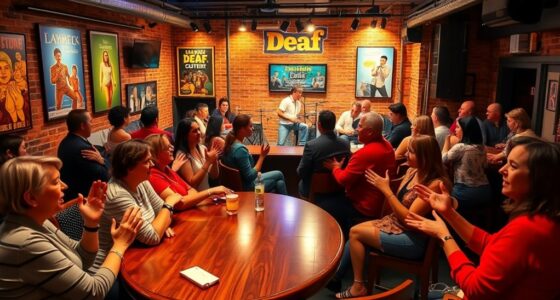Deaf-friendly restaurants and cafes are designed to make dining accessible and enjoyable for everyone. They feature signs in sign language, visual menus, and staff trained in ASL or other sign languages. Many use digital tools, gesture guides, and unique visual cues to communicate effectively. Some establishments are Deaf-owned and focus on cultural pride and community events. If you want to discover how these venues create welcoming spaces, you’ll find plenty of ideas and tips here.
Key Takeaways
- Deaf-friendly restaurants employ visual menus, sign language signage, and digital tools to facilitate accessible communication.
- Many establishments are Deaf-owned, promoting cultural pride and inclusive employment for Deaf staff.
- Features like ASL-fluent staff, visual aids, and technology (tablets, screens) enhance customer interactions.
- Community-focused cafes host Deaf events, cultural showcases, and sign language workshops to foster connection and pride.
- Resources such as directories and online guides help locate and support deaf-inclusive eateries worldwide.
Notable Deaf-Owned Dining Establishments Worldwide

Around the world, Deaf entrepreneurs have made a significant mark by opening notable dining establishments that celebrate culture and independence. You’ll find many of these restaurants feature all-Deaf staff, including chefs and waitstaff, fostering a welcoming and culturally rich environment.
For example, France’s first Deaf-owned restaurant, opened by Sid Nouar in 2001, started with Moroccan cuisine and expanded in 2018 to an all-Deaf staff.
In Texas, Vladimir and Inna Giterman launched a thriving chain of Deaf-owned crêpe restaurants, beginning as a food truck and growing into cafes and franchises.
These establishments prioritize community support and employ Deaf staff to promote cultural pride, often incorporating visual menus and sign language signage. Such venues create inclusive spaces where Deaf and hearing customers can enjoy diverse culinary experiences.
Innovative Accessibility Features in Deaf-Friendly Venues

Deaf-friendly venues are pioneering innovative features that make dining experiences more accessible and seamless. For example, some deaf-owned restaurants, like Mozzeria, use visual signage, gestures, and written tools to communicate effectively. Other venues incorporate technology to bridge communication gaps. At Culver’s in Buffalo Grove, drive-thru bell systems notify staff of deaf customers’ orders, eliminating the need for spoken requests. Tatsu Ramen in Los Angeles employs digital ordering screens, streamlining service. Starbucks’ Signing Stores in Washington, D.C., feature deaf staff fluent in ASL and accessible seating designed to reduce glare. These innovations create inclusive environments where deaf patrons can enjoy meals without barriers. The table below highlights some of these features:
| Feature | Location | Purpose |
|---|---|---|
| Drive-thru bell system | Buffalo Grove | Direct communication with staff |
| Digital ordering screens | Los Angeles | Reduce barriers, streamline service |
| Accessible seating, ASL staff | Washington, D.C. | Enhance communication and comfort |
Additionally, many of these venues are adopting privacy and cookie policies to improve user experience and ensure accessibility. These advancements demonstrate how integrating innovative accessibility features can significantly enhance the dining experience for deaf patrons. Furthermore, some venues are training staff in ASL to foster more meaningful interactions with deaf customers.
Effective Communication Methods for Deaf Patrons

Effective communication is essential for guaranteeing that deaf patrons can enjoy their dining experience without frustration or misunderstandings. Visual communication plays a key role in this, allowing staff and customers to exchange information clearly. Many deaf-friendly restaurants use sign language as the primary communication method, fostering direct and effective interactions. Visual aids like illustrated menus, signage, and gesture guides help you and staff communicate menu items and orders without spoken words. Digital tools such as tablets, apps, and screens enable quick ordering and reduce wait times. Additionally, communication devices like notepads and drive-thru bells let you request service or clarify orders independently. Staff training in sign language and visual communication techniques ensures respectful, consistent service, making your visit more comfortable and accessible. Incorporating visual communication methods such as crochet styles for locs into staff uniforms or décor can also create a welcoming environment for diverse guests. Emphasizing training in visual communication techniques helps staff better understand and meet the needs of deaf patrons, fostering inclusive dining experiences. Furthermore, understanding the importance of personalized communication can enhance the overall experience by addressing individual preferences and needs more effectively. Integrating ethical hacking principles, such as safeguarding customer data, can also build trust and ensure a secure dining environment for all patrons.
Highlighted Deaf-Friendly Restaurants in Major Cities

Several major cities worldwide have embraced inclusive dining by hosting restaurants and cafes that prioritize deaf-friendly practices. Many of these establishments are owned and operated by deaf owners, ensuring authentic communication and understanding. In Mumbai, Mirchi and Mime showcase deaf owners who employ deaf staff, creating a welcoming environment. San Francisco’s Mozzeria is another example, run by deaf entrepreneurs dedicated to inclusive service. Sydney’s Rashays Punchbowl transformed into a deaf-friendly space by training staff in Australian sign language, enhancing customer experience. Washington D.C. features Starbucks Signing Stores with deaf staff fluent in ASL, allowing customers to communicate using sign language or writing tablets. These restaurants demonstrate how deaf owners lead the way in fostering accessible and inclusive dining experiences worldwide. Recognizing the importance of effective communication, many of these venues prioritize sign language proficiency among their staff to ensure a seamless and welcoming experience for deaf patrons. Furthermore, many of these establishments incorporate innovative architectural solutions to improve accessibility and create more welcoming environments for deaf and hard-of-hearing customers, emphasizing the significance of energetic alignment in fostering positive interactions.
Community-Focused Cafes Supporting Deaf Culture

Community-focused cafes like Mozzeria and Pah! celebrate Deaf culture through vibrant décor, signage, and cultural events that foster pride. They incorporate sign language into daily operations, making communication accessible and inclusive. These cafes also host community events that promote Deaf language, traditions, and social connection, creating a welcoming environment that embraces and elevates Deaf identity while fostering Vetted Halloween Product Reviews. Implementing inclusive design elements and accessibility features further enhances the experience for Deaf patrons, ensuring that universal design principles are upheld to accommodate diverse needs. Additionally, adopting growth mindset principles can help these establishments continually improve their services and community engagement efforts, demonstrating a commitment to emotional support and inclusivity.
Deaf Culture Celebrations
Have you ever wondered where Deaf culture truly comes alive? It’s often in community-focused cafes that celebrate Deaf heritage through vibrant events and traditions. These cafes host festivals, sign language poetry readings, and cultural showcases that highlight Deaf art and storytelling.
They serve as gathering spaces where Deaf individuals can freely express their identity, share experiences, and build pride. Many of these cafes feature visual signage, murals, and Deaf-centric programming, making the environment welcoming and educational for all visitors.
Participating in these celebrations strengthens connections within the Deaf community and spreads awareness among hearing guests. By attending these events, you help support Deaf culture’s significance and promote understanding of its rich history and unique language. AI Bifurcation offers insights into how technological advancements can also influence emerging cultural spaces and community engagement.
Sign Language Integration
Sign language integration is an essential feature of cafes that support Deaf culture, making communication more accessible and inclusive. By incorporating sign language into menus and signage, these cafes break down barriers, allowing deaf and hearing patrons to connect effortlessly. Staff trained in American Sign Language (ASL) or local sign languages create a seamless dining experience, while visual cues and illustrated menus assist everyone in placing orders confidently. These cafes serve as cultural hubs, fostering Deaf pride and awareness through active use of sign language. The following table highlights emotional connections fostered by sign language integration: | Connection | Impact | |————–|———| | Understanding | Builds trust and respect | | Inclusion | Celebrates Deaf culture | | Community | Strengthens shared identity | Furthermore, incorporating active communication strategies enhances the overall experience, ensuring all patrons feel valued and understood. Additionally, implementing cultural awareness training for staff further deepens the connection between patrons and staff, promoting a more welcoming environment. Emphasizing sign language education within these spaces encourages ongoing learning and fosters greater appreciation for Deaf culture. Incorporating visual communication tools can also significantly improve clarity and comfort for all visitors. Exploring accessible design elements can further enhance the environment, making it more accommodating for diverse needs.
Inclusive Community Events
Inclusive community events play an essential role in supporting Deaf culture within cafes by creating opportunities for meaningful connection and cultural celebration. These events, like sign language workshops, deaf art exhibits, and storytelling nights, promote cultural awareness and foster inclusion. Utilizing self-watering plant pots as a metaphor, these cafés cultivate a nurturing environment where deaf and hearing individuals can grow together. As a patron, you’ll find these cafes serve as social hubs where deaf and hearing individuals can share experiences and build relationships in a welcoming environment. Many cafes partner with deaf organizations to sponsor events that honor deaf heritage, language, and community achievements. Special events, such as deaf comedy nights or film screenings, further encourage community engagement and pride. Participating in inclusive community events helps reduce social isolation among deaf individuals and strengthens the sense of belonging within the vibrant deaf community. Creating accessible event spaces with appropriate visual communication tools ensures all members can participate fully and comfortably.
Technology and Signage Enhancing Dining Accessibility

Technology and signage play a key role in making dining experiences more accessible for deaf customers. Digital ordering systems and visual communication tools help you understand menus and place orders easily, without relying on spoken words.
These innovations create a more inclusive environment where everyone can enjoy their meal comfortably.
Visual Communication Tools
Visual communication tools play a crucial role in making dining experiences more accessible for Deaf customers. Sign language charts, illustrated menus, and pictograms help both Deaf and hearing patrons identify menu items quickly and accurately, reducing miscommunication.
Digital screens and tablets streamline ordering by providing visual interfaces that allow you to select and pay effortlessly. These tools eliminate language barriers and make the process more efficient.
Additionally, signage with common signs and symbols promotes independence and inclusivity, enabling you to communicate effectively without spoken words.
Digital Ordering Systems
Digital ordering systems like touchscreen kiosks and tablet menus transform the dining experience for Deaf customers by allowing you to place orders independently and confidently. These systems feature visual menus, sign language video guides, and customizable text inputs, making communication easier and more accessible.
You can navigate menus visually, view sign language demonstrations for menu items, and customize orders with ease. Restaurants often display digital signage showing sign language gestures for common dishes, helping both staff and customers understand orders better.
Additionally, virtual interpreters and apps support real-time communication, reducing errors and wait times. These innovations considerably improve inclusivity, especially considering that 42% of deaf individuals previously left drive-thru lines due to communication barriers.
Digital ordering systems truly enhance your dining independence and comfort.
Unique Dining Experiences Celebrating Deaf Culture

Many deaf-friendly restaurants and cafes create unique dining experiences that celebrate Deaf culture by integrating visual and gesture-based communication methods.
Deaf staff play a crucial role, using sign language and gestures to communicate with customers, fostering an inclusive atmosphere.
Deaf staff use sign language and gestures to create an inclusive, welcoming dining experience for all.
These establishments often feature visual menus, sign language signs, and gesture-based ordering systems, making it easy for everyone to participate.
They serve as cultural hubs, showcasing Deaf art, sign language, and community stories that highlight Deaf identity.
Innovative practices like sign language greeting signs and illustrated menus provide authentic cultural experiences.
Additionally, these cafes often offer educational opportunities, encouraging patrons to learn sign language and deepen their understanding of Deaf culture, creating a space where food and community come together beautifully.
Recommendations for Finding Deaf-Inclusive Eateries

Finding deaf-inclusive eateries involves knowing where to look and what features to prioritize.
As a deaf couple, you should seek out restaurants with staff trained in American Sign Language (ASL) or other sign languages, like Starbucks’ Signing Stores.
Look for deaf-owned establishments such as Pah! in Portland or Mozzeria in San Francisco, which emphasize accessible communication.
Also, check for venues that offer visual aids, sign language menus, or communication tools like tablets, notepads, or visual boards.
To make your search easier, explore local or online resources that list deaf-friendly restaurants, including community groups and directories.
Prioritizing these features helps ensure a seamless, enjoyable dining experience where communication isn’t a barrier.
Frequently Asked Questions
How Do Deaf People Order Food at Restaurants?
You might wonder how deaf people order food at restaurants. They often use American Sign Language (ASL) or their local sign language to communicate directly with staff.
Many places have visual menus, sign language illustrations, or written options. Some use tablets or pen-and-paper to specify orders.
While drive-thrus have visual signals or bells, innovative restaurants may offer digital screens or virtual interpreters, making ordering accessible and smooth for deaf customers.
How Can Restaurants Be More Deaf Friendly?
Did you know that nearly 15% of the world’s population has some form of hearing loss? To be more deaf-friendly, you can train your staff in sign language and deaf culture, making communication smoother.
Add visual aids like illustrated menus and signs, and install accessible devices such as call buttons or digital screens.
Creating dedicated spaces for deaf customers also shows your commitment to inclusivity and enhances their dining experience.
Can a Deaf Person Work in a Restaurant?
Yes, you can work in a restaurant if you’re deaf. Many deaf individuals excel as chefs, servers, and managers by using sign language, written notes, or technology.
Employers often provide training and communication tools to support you. With your skills and dedication, you can succeed in any role, just like deaf workers at fully staffed restaurants.
Your unique perspective can add value to the team and enhance customer experiences.
Conclusion
Discover delightful deaf-friendly dining destinations that dazzle with dedication and design. By embracing innovative ideas, inclusive communication, and community connections, you’ll find fulfilling food experiences everywhere. Seek out specific spots, stay savvy about signage, and support spaces that celebrate deaf culture. With a little exploration, you’ll enjoy engaging eateries that empower, educate, and enrich your every meal. Immerse yourself in these deaf-friendly dining delights and discover a world of welcoming, wonderful, and wonderful ways to dine!











